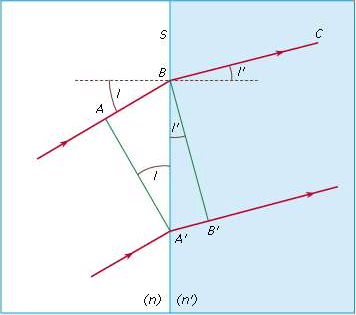The law of refraction | Additional Documents & Tests for IIT JAM PDF Download
When a ray of light meets the surface of separation between two transparent media, it is sharply bent or refracted. Because rays are really only directions and have no physical existence, the passage of light waves through a surface must be considered if refraction is to be understood. Refraction effects are based on the fact that light travels more slowly in a denser medium. The ratio of the velocity of light in air to its velocity in the medium is called the refractive index of the medium for light of a particular colour or wavelength. The refractive index is higher for blue light than for light at the red end of the spectrum.
In Figure , AA′ represents a plane wave of light at the instant that A′ meets the plane refracting surface A′B separating two media having refractive indices n and n′, respectively. During the time taken by the light to travel from A to B in material n, light travels from A′ to B′ in material of refractive index n′, forming the new wave BB′ in the second material, proceeding in direction BC. Hence, the relationship n′/n = AB/A′B ′ can be obtained; and dividing numerator and denominator by BA′ gives

Figure: The law of refraction. Plane light wave at position AA in medium of index n and BB' in medium of index n' (see text).
 (1)
(1)
The angles I and I′ are called the angle of incidence and angle of refraction between the refracting surface and the incident and refracted waves, respectively.
Returning now to the convention of considering the movement of light in terms of rays because entering and emerging rays are always perpendicular to the light waves they represent, angles I and I′ also denote the angles between the entering and emerging rays and the normal (perpendicular) line to the refracting surface at B.
Equation (1), known as the law of refraction, is generally written: n′ sin I′ = n sin I.
 (2)
(2)

|
Explore Courses for IIT JAM exam
|

|

















